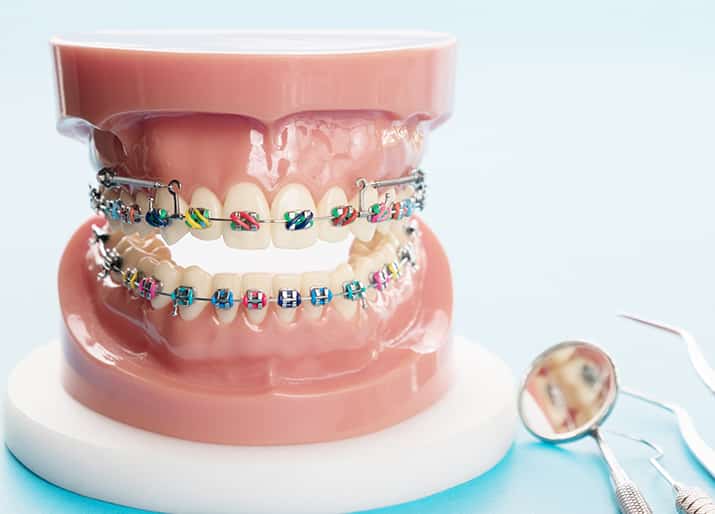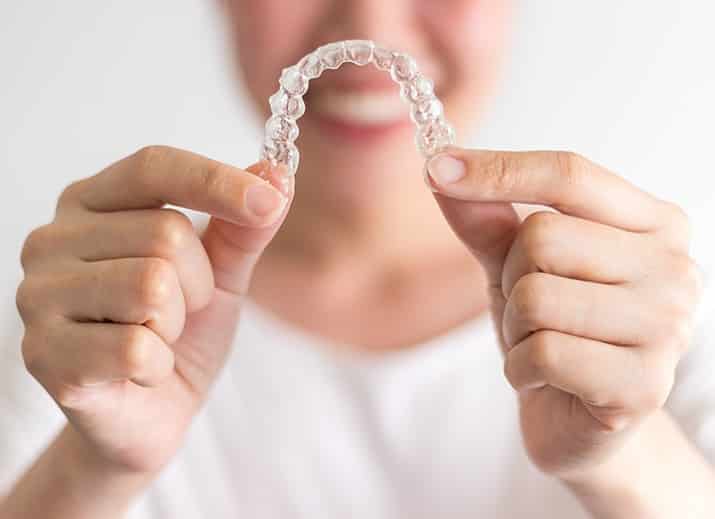Children’s braces and Invisalign with a registered specialist orthodontist at Smile Solutions.
Conventional and Clear Braces
Orthodontic appliances have come a long way. As well as traditional metal (stainless steel) braces, clear or ceramic (porcelain) braces are available; these match the surrounding tooth colour, are more aesthetically pleasing and are virtually invisible from 2 to 3 metres away.
Both traditional and clear braces work in the same way: a series of brackets with a wire arch running through the slots of the bracket are attached to the surface of each tooth, and when the wire is tensioned these slowly guide the teeth into position.
At Smile Solutions we use Empower braces, in both stainless steel and porcelain. Empower usually eliminates the need for elastic or metal module “ties” to hold the wire in place. This makes them discreet, comfortable and easy to keep clean. Eliminating elastic ties can reduce the amount of plaque that is usually attracted to the braces, making it easier to maintain dental hygiene during orthodontic treatment and resulting in fresher breath.
Learn MoreInvisalign Teen
Invisalign Teen is the almost invisible alternative to braces for young people. With Invisalign, teeth are gradually moved into place by means of custom-made clear aligners that are changed every two to three weeks until the teeth are in the desired position.
Teenagers being treated with Invisalign can remove the aligners to eat, brush their teeth, and play sport or a musical instrument, or even for a special occasion. Aligners simply need to be worn for the prescribed 22 hours per day to be effective within the treatment time prescribed by your orthodontist.
At Smile Solutions your child’s treatment will be carried out by one of our registered specialist orthodontists, not a general dentist. Call 13 13 96 to book a consultation to better understand your child’s needs and treatment options available.
Learn MoreSpace Maintainers
When a primary tooth is lost prematurely (usually due to decay), adjacent teeth may drift into the space and leave insufficient room for proper alignment of the developing permanent teeth. Our specialist paediatric dentist and specialist orthodontists will advise you as to whether a space-maintaining device is necessary. Space maintainers can be fixed or removable, depending on the individual case.
Dental Crowding and Early Intervention to Avoid Extractions
If dental crowding is noted in a young child, removable orthopaedic plates can be utilised from the age of six to eight years. To expand the arches or maintain premolar spaces and avoid the need for later extractions, orthodontic braces may follow. Early intervention is usually achieved with simple removable appliances, but treatment is often continued until all the teeth have erupted. Fixed braces are then used to complete the alignment.
Snoring and Low Tongue Position Problems
Childhood snoring is a possible sign of partial airway obstruction and is a potentially serious problem that can affect a child’s daytime mood, educational development and facial development. Occasionally, the problem is due to narrowness of the upper jaw. Early expansion may help to improve nasal airflow and restore normal sleeping patterns. We work in conjunction with ENT (ear, nose and throat) specialists and a children’s sleep specialist to provide orthodontic care for children with snoring problems.
Orthodontic Treatment of Jaw Growth Problems in Children
In some children, a growth imbalance between the top and bottom jaws (the maxilla and the mandible) makes it impossible to bite correctly. This is often an inherited problem. To compensate, expansion of either jaw and promoting forward growth can be useful. Recent studies have indicated that early intervention, when the child is aged six to eight, can be advantageous. Smile Solutions’ specialist orthodontists work in conjunction with our oral & maxillofacial surgeons – Dr Patrishia Bordbar and Dr Ricky Kumar – in the effective dental management of children with jaw problems who may also require orthognathic surgery.
Meet our Specialist Orthodontists
At Smile Solutions your Invisalign treatment will be carried out by one of our registered specialist orthodontists, not a general dentist. Specialist orthodontists complete a postgraduate university degree specialising in tooth and jaw correction and these are the clinicians who will assess your suitability for Invisalign and perform your treatment. You can have complete confidence in the care you receive and the final outcome.
Frequently Asked Questions
The length of your orthodontic treatment can depend on the problem to be treated and on how much movement is needed to bring the teeth into the desired position. Treatment can vary from a few months in straightforward cases to two to three years for very complex cases. Another factor is the type of treatment option you choose; treatment with conventional braces is likely to have a different timeframe from treatment with Invisalign. Your treating orthodontist will be able to give you a time estimate at your initial consultation.
The cost of your orthodontic treatment will be determined after a consultation with an orthodontist. The average cost for conventional braces starts at $9,300 for both arches. Full Invisalign treatment starts at $11,300. Treatment complexity and subsequent costs can vary greatly among individuals, so please call us to arrange a consultation.
Orthodontic treatment is suitable for people of all ages. The usual time to start orthodontic treatment in the form of braces is at around 11 to 14 years of age, when most permanent teeth have come through, but you can start treatment at any age. At Smile Solutions we see many adult patients who did not have orthodontic treatment when younger or whose teeth have moved since their previous treatment.
Some general dentists have obtained certification that entitles them to carry out Invisalign treatment. However they are not specialists and are not qualified to treat with any other type of braces.
For treatment with braces you need to see a specialist orthodontist. These practitioners have had three to four years of additional training in the specific field of orthodontics on top of their dental degree. The training qualifies them for registration with the Dental Board of Australia as a specialist and enables them to gain comprehensive experience in their field of expertise, with their sole professional focus being on correcting the position of teeth.
Seeing a specialist orthodontist for your orthodontic treatment means you receive specialist care from a highly trained and experienced expert.
It is normal to experience slight discomfort when braces are first fitted or Invisalign is applied. This is normal and is typically described as a feeling of pressure. Feeling discomfort during any orthodontic treatment is a good sign as it indicates that your teeth are moving into their new positions.
The discomfort typically dissipates after a couple of days as the wearer becomes accustomed to the new tension or aligners. Over-the-counter pain management can also help, if required.
Invisalign is a modern breakthrough in orthodontics with many advantages over conventional braces. Probably the number one reason Invisalign is a favourite alternative to braces is the fact that the aligners are clear and therefore very hard to see. A lot of people who want straighter teeth are put off by the appearance of conventional metal braces, making Invisalign much more appealing. As well as being nearly invisible, Invisalign is also a comfortable and less bulky orthodontic treatment, without the need for metal brackets and wires.
Another benefit of choosing Invisalign is that the aligners are removable. This makes it easier to look after your oral hygiene during treatment; you can still brush and floss as you normally would – just take the aligners out when you need to clean your teeth. The same is true for eating and drinking: because you can remove Invisalign, the treatment does not stop you eating particular foods.
Even those who have had other orthodontic treatment that they are not happy with, or those whose teeth have moved since other treatments, are eligible for Invisalign.
Invisalign can address most but not all teeth straightening concerns.
To ascertain your suitability for orthodontic treatment with Invisalign, Smile Solutions offers a free Invisalign consultation. At this appointment we will assess your suitability for Invisalign and determine what treatment is best for your individual case. You will receive a comprehensive quote and treatment plan and you’ll even get to see a projection of what your smile will look like at the end.
The time taken to complete treatment depends on the complexity of your orthodontic needs, but the average is 12 to 18 months.
After a consultation with one of our specialist orthodontists, you will receive a full treatment outline. This will give you an approximate timeframe, including the time required for any general dental work in preparation for your Invisalign treatment.
Excellent oral hygiene is crucial for anyone wearing braces. Please take particular care to keep the areas around your braces and gum line free from plaque. We recommend you use your toothbrush, along with Superfloss™ and Pixsters™, after snacks and meals. Superfloss™ has a stiffened end that can be threaded between your teeth and the wire, a spongy section to floss large spaces and smooth end for smaller ones. In addition, you can use Pikster™ inter-dental brushes to clean between your teeth and the arch wire. With bendable heads, these can easily reach around to your back teeth and will last up to two weeks when properly rinsed after each use.
If you are finding it hard to clean your teeth or notice that your gums seem puffy or bleed easily, we recommend more frequent visits to your dentist or hygienist for professional hygiene therapy.






